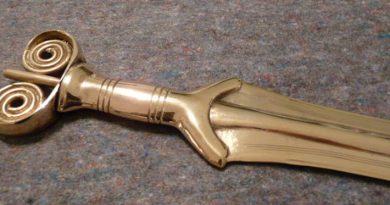“Minoan” Akrotiri – Santorini
Excavations starting in 1967 at the site called Akrotiri under the late Prof. Spyridon Marinatos have made Thera the best-known “Minoan” site outside of Crete, the homeland of the culture.
The island was not called Thera at the time. Only the southern tip of a large town has been uncovered, yet it has revealed complexes of multi-level buildings, streets and squares, with remains of walls standing as high as 8 meters, all entombed in the solidified ash of the famous eruption of Thera. The site was not a palace-complex such as are found in Crete, but its excellent masonry and fine wall-paintings show that this was no conglomeration of merchants’ warehousing either. A loom-workshop suggests organized textile weaving for export.
The oldest signs of human settlement are Late Neolithic (4th millennium BC or earlier), but ca 2000–1650 BC Akrotiri developed into one of the Aegean’s major Bronze Age ports, with recovered objects that had come not just from Crete but also from Anatolia, Cyprus, Syria and Egypt, from the Dodecanese and the Greek mainland.Pipes with running water and water closets found on Thera are the oldest such utilities discovered. The pipes run in twin systems, indicating that the Therans used both hot and cold water supplies. The hot water’s origin was probably geothermic, given the volcano’s proximity.
Fragmentary wall-paintings at Akrotiri lack the insistent mythological content familiar in both Greek and Christian decor. Instead, the Minoan frescoes depict “Saffron-Gatherers”, who offer their crocus-stamens to a seated lady, perhaps a goddess; in another house two antelopes, painted with a kind of confident, flowing decorative, calligraphic line; the famous fresco of a fisherman with his double strings of fish strung by their gills; the flotilla of pleasure boats, accompanied by leaping dolphins, where ladies take their ease in the shade of light canopies.
Akrotiri Santorini
Lat: 36.35743955276214
Long: 25.3948974609375

